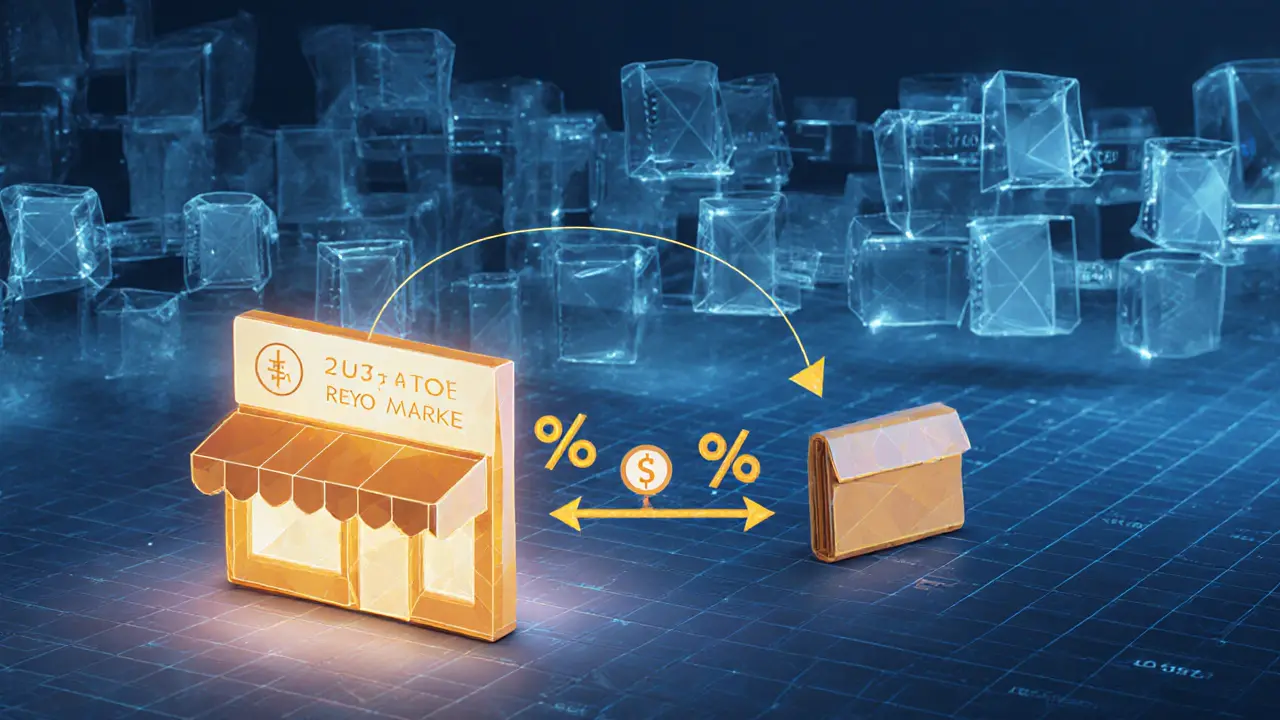How NFTs Enable Content Ownership & Automatic Royalties

NFT Royalty Calculator
Enter the original sale price, royalty percentage, and resale price to see how much royalty payment the creator would receive.
Royalty Amount
$0.00Creator receives this amount when NFT is resold
Example: If you minted for $1,000 with a 5% royalty and it sells for $10,000, the creator would receive $500.
When creators talk about NFTs, they refer to unique digital tokens stored on a blockchain that certify ownership of a specific piece of content. Royalty clauses can be baked into the token’s code, so every time the token changes hands, the original creator gets a slice of the resale price. This "set‑and‑forget" model is reshaping how artists, musicians, and video producers monetize their work. NFTs give you a tamper‑proof proof of ownership, while smart contracts handle the payment flow without a middle‑man.
Why NFTs Matter for Content Ownership
Traditional digital files are easy to copy, and proving who originally created a piece often requires legal paperwork. NFTs solve that problem because each token lives on an immutable ledger - most commonly Ethereum. When you mint an NFT, you choose a token standard such as ERC‑721 for a single‑edition artwork or ERC‑1155 for semi‑fungible items like game skins. The blockchain records the creator’s address, the token ID, and any attached metadata (image link, description, etc.). Anyone can verify that address, making disputed ownership claims practically impossible.
How NFT Royalties Work
During the minting process, the creator defines a royalty percentage inside a smart contract. The most common range is 2.5 %‑15 %, with 5‑6 % becoming the industry norm. When a collector buys the token on a secondary market, the marketplace calls the contract, which automatically calculates the royalty amount and sends it to the creator’s digital wallet. No paperwork, no invoicing - the blockchain does the work.
Example: an artist mints a piece for $1,000 with a 5 % royalty. A year later, a collector resells it for $10,000. The smart contract instantly transfers $500 to the artist’s wallet, while the seller receives $9,500. The transaction is recorded on‑chain, giving both parties a transparent receipt.
Setting Up Royalties - A Step‑by‑Step Checklist
- Select a minting platform. OpenSea, Foundation, and SuperRare all offer UI‑driven royalty settings.
- Connect your wallet. MetaMask on Ethereum is the most common choice; alternatives like Coinbase Wallet work on other chains.
- Choose a token standard. ERC‑721 for single pieces, ERC‑1155 for collections.
- Enter royalty details. Most platforms let you type a percentage; some allow split royalties for collaborators.
- Pay the gas fee. As of 2024, minting on Ethereum costs roughly $50‑$200 depending on network congestion.
- Publish and promote. Once minted, the NFT appears in your wallet and can be listed for sale.
For creators who need custom splits (e.g., 70 % to the artist, 30 % to a producer), they may need to write their own contract or use tools like Manifold or Juicebox, which add extra logic beyond the platform UI.

NFT Royalties vs. Traditional Licensing - Quick Comparison
| Aspect | NFT Royalties | Traditional Licensing |
|---|---|---|
| Payment Trigger | Automated on‑chain sale | Invoice after royalty period ends |
| Transparency | Public ledger records every payment | Often opaque, relies on collection agencies |
| Enforcement | Depends on marketplace compliance; on‑chain contracts enforce only where supported | Legal contracts, court enforcement possible |
| Global Reach | Anyone with internet can trade | Usually limited by territorial rights |
| Cost to Creator | Set percentage; no ongoing legal fees | Legal fees, collection agency cuts (often 20‑30 %) |
Current Market Landscape
By the end of 2024, the NFT royalty ecosystem generated roughly $150 million in creator payouts, a fraction of the $2.5 billion total NFT market. Platforms that honor royalties, such as OpenSea and Foundation, still dominate art‑focused collections, with compliance rates around 70‑80 %. Newer marketplaces like Blur and LooksRare have made royalties optional, pulling about 30 % of volume by offering lower fees. This split creates a dual environment: creators who value steady income tend to list on royalty‑friendly sites, while speculators chase the cheapest‑fee platforms.
Regulatory chatter is heating up. The European Union’s MiCA proposal, slated for enforcement in 2025, may require platforms operating in the region to enforce creator‑set royalties or face penalties. If adopted, the compliance gap could shrink dramatically, pushing optional‑royalty platforms to adapt or lose access to EU users.

Challenges and Emerging Solutions
Despite the elegance of smart contracts, royalty enforcement remains a pain point. A marketplace can simply ignore the royalty call, especially if the token is transferred off‑chain or through a peer‑to‑peer exchange. Analysts at a16z note that buyers may deliberately use royalty‑free routes to maximize profit, which erodes the creator’s revenue stream.
Developers are experimenting with "right‑of‑reclaim" models: if a sale occurs without paying the royalty, the contract can trigger a revocation of the token, forcing the new owner to negotiate with the creator. This adds complexity and may deter collectors who value liquidity.
Another direction is the rise of "soulbound" tokens (EIP‑4993), which lock the NFT to a single wallet unless a royalty is paid. While this guarantees payment, it also removes the tradable nature many users love, creating a trade‑off between revenue certainty and market activity.
Future royalty designs may shift from flat percentages to dynamic structures. Time‑decay royalties start high and taper off after several years, reflecting the diminishing novelty of a work. Utility‑based royalties tie payment to how the NFT is used-for example, a music NFT could generate a small fee every time it streams on a partner platform.
Practical Tips for Creators
- Pick a realistic royalty rate. 3‑5 % works well for most art; higher rates can choke secondary market activity.
- Audit marketplace policies. Before minting, verify whether the platform respects EIP‑2981 or its own royalty standard.
- Consider split royalties. If you collaborated with a producer, use tools like Manifold to allocate percentages at mint time.
- Track tax obligations. Royalty income is taxable in most jurisdictions; keep records of each on‑chain payment.
- Stay updated on regulations. EU MiCA, US SEC guidance, and local copyright laws may affect how royalties are reported.
Where to Go Next
If you’re ready to mint, start with a platform that offers a guided royalty setup - OpenSea’s "Creator Earnings" feature is a good entry point. For custom splits or experimental models, explore Solidity tutorials on GitHub or services like Juicebox that let you launch a full‑featured contract without deep coding.
Watch the evolving standards: EIP‑2981 continues to gain adoption, and the upcoming EIP‑4907 adds rental capabilities, opening new revenue streams beyond resale.
Can I receive royalties on any blockchain?
Most royalty implementations are built on Ethereum because of its mature standards (ERC‑721, ERC‑1155, EIP‑2981). However, chains like Solana, Polygon, and Tezos now support similar features, though marketplace support varies. Choose a chain where your target audience already trades.
Do royalties count as income for taxes?
Yes. Every time a royalty is paid on‑chain, it’s considered earned income in most tax regimes. Keep a spreadsheet of wallet addresses, timestamps, and USD equivalents for accurate reporting.
What happens if a marketplace ignores my royalty settings?
If the platform doesn’t enforce royalties, the smart contract can’t force payment off‑chain. Some creators choose to only list on compliant sites or use "right‑of‑reclaim" contracts that revoke the token when royalties aren’t paid.
How do I set up split royalties for multiple collaborators?
Platforms like Foundation and Manifold let you add multiple payout addresses with percentages at mint time. For fully custom splits, you’ll need a Solidity contract that defines an array of recipients and their shares.
Will future regulations force all marketplaces to honor royalties?
The EU’s MiCA framework is the most advanced proposal; it could require royalty enforcement for platforms operating in the bloc. Other regions are watching, so compliance may become a global norm over the next few years.

Jenna Em
October 21, 2025 AT 08:44They say the blockchain is neutral, but who really decides which rules stick. Every time a token jumps hands, a tiny piece of data gets stamped on a public ledger that no one can erase. That sounds like freedom, until you realize the ledger is run by a handful of huge validators. If those validators collude, they could rewrite royalty logic without anyone noticing. So the promise of “set‑and‑forget” might just be a front for hidden control.
Stephen Rees
October 24, 2025 AT 20:04It’s comforting to think that code can replace lawyers, yet the same code can be tweaked behind the scenes. We trust smart contracts, but those contracts are written by people with agendas. When a marketplace decides to ignore royalty calls, the creator is left to chase ghosts. The illusion of automation often masks the same power dynamics we’ve always had.
Katheline Coleman
October 28, 2025 AT 06:24Dear fellow participant, I appreciate the concerns raised regarding the enforceability of on‑chain royalty mechanisms. While the decentralised architecture indeed diminishes the necessity for traditional intermediaries, it simultaneously introduces reliance upon the governance policies of individual marketplaces. Consequently, creators should conduct due diligence concerning the compliance frameworks of each platform prior to minting. Moreover, integrating multisignature controls or employing escrow‑based royalty disbursement can mitigate the risk of unilateral alterations. In summary, a judicious blend of technical safeguards and contractual awareness remains indispensable.
Amy Kember
October 31, 2025 AT 17:44Look, royalties work only if the market respects them. If a sale happens off‑chain the contract is irrelevant. Creators need to pick platforms that actually call the royalty function. Otherwise you’re just handing over value for free.
Evan Holmes
November 4, 2025 AT 05:04Most of this is hype that ignores the real cost of gas.
Isabelle Filion
November 7, 2025 AT 16:24Ah, the dazzling allure of NFTs, the panacea for every creative’s financial woes.
One merely whispers a royalty percentage into the ether and watches the blockchain magically dispense income.
It is, of course, a revelation that the same technology capable of minting pixelated apes can also guarantee perpetual earnings.
Let us not forget that the underlying networks demand astronomical fees, turning modest artists into paupers.
The promise of “set‑and‑forget” is, in reality, a cleverly disguised subscription to perpetual volatility.
Meanwhile, discerning collectors flock to platforms that conveniently ignore royalty calls, rendering the entire model moot.
Regulators, ever‑the vigilant guardians, now contemplate imposing mandates that would force compliance, a notion that would surely improve the user experience.
Yet the community remains blissfully unaware that enforcement mechanisms are little more than polite requests.
A ‘right‑of‑reclaim’ clause sounds noble until it freezes liquidity and scares away potential buyers.
Soulbound tokens, those charming immobile assets, provide certainty at the expense of market dynamism.
Dynamic royalty structures, such as time‑decay or usage‑based fees, are touted as the next evolution, though they add layers of complexity that only lawyers enjoy.
The optimistic narrative overlooks the fact that most secondary markets are driven by speculation, not by the creator’s sustained relevance.
Consequently, the average artist receives a pittance, while early adopters reap the lion’s share of profits.
In sum, the blockchain does not so much democratise royalties as it migrates old power structures onto a new ledger.
One can only admire the ingenuity of a system that pretends to empower while quietly preserving the status‑quo.
Rebecca Kurz
November 11, 2025 AT 03:44Honestly, the whole royalty thing feels like a hidden tax, a silent levy baked into code, and we all just nod because we don’t understand the fine print, while the big platforms keep the bulk of the fees, and the regulators pretend they’re looking out for us, but really they’re just watching the money flow.
Nikhil Chakravarthi Darapu
November 14, 2025 AT 15:04It is worth noting that the original blockchain innovations originated in regions that champion open source values, and any attempt to impose foreign regulatory frameworks on these decentralized networks threatens the very principle of digital sovereignty.
Patrick Day
November 18, 2025 AT 02:24Dude, they’re probably already planting backdoors in the smart contracts so the “sovereignty” talk is just a smokescreen, just another way to keep control.
Ryan Comers
November 21, 2025 AT 13:44🙄 Wow, the drama never ends – while everyone cries about freedom, the real power brokers are laughing behind their screens, swapping royalties like poker chips, and we’re left to applaud the spectacle. 🎭
Mike Cristobal
November 25, 2025 AT 01:04It’s morally indefensible to profit from artists while sidestepping the very royalties they’re owed. 😊 We must hold marketplaces accountable and demand transparent enforcement of creator rights.
Elizabeth Chatwood
November 28, 2025 AT 12:24yeah i totally get u, lets keep pushin for fair pay and make sure every creator gets their cut keep it real